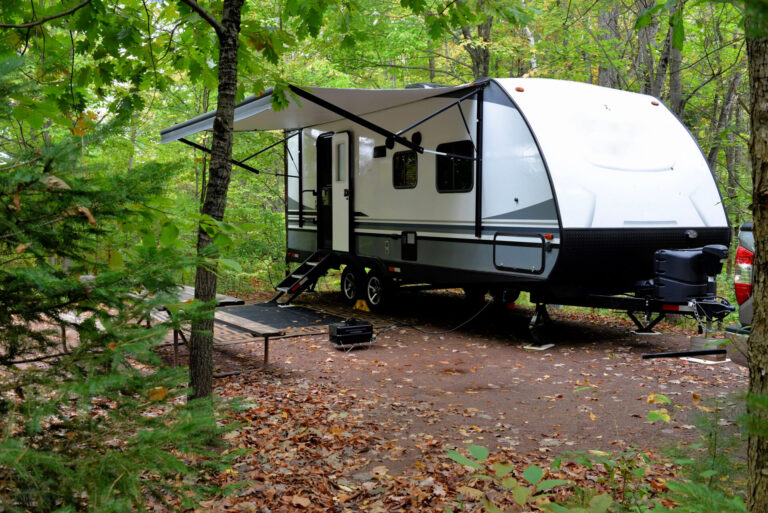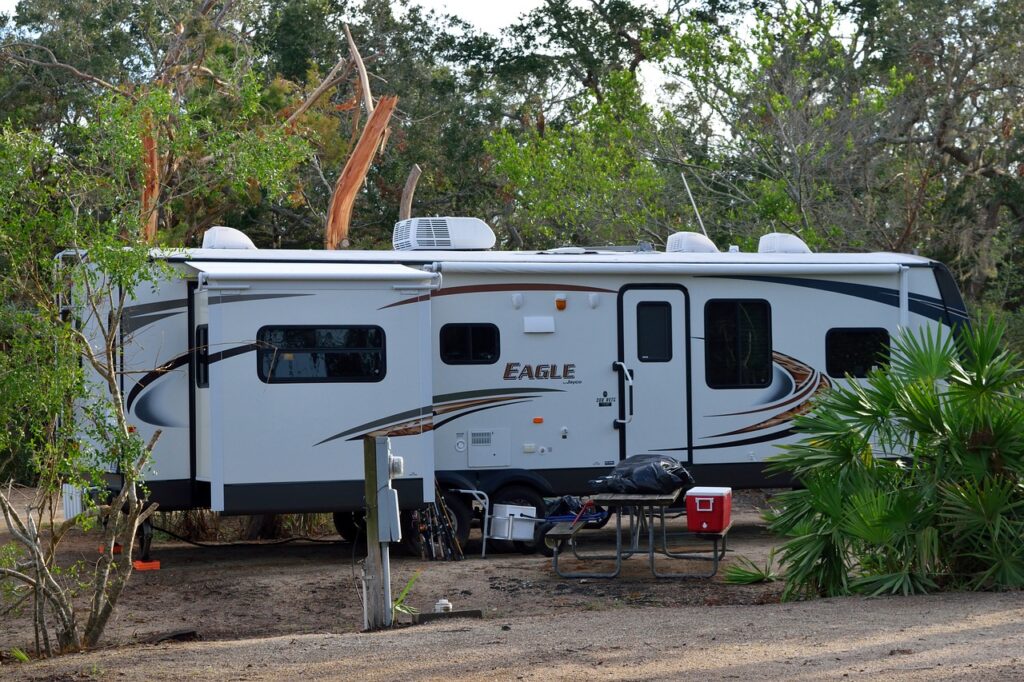
Congratulations, you’re about to buy your first travel trailer! You are going to love the freedom of traveling to unseen places and experiencing the great outdoors. Travel trailers date back the the 1800s when they were pulled behind horses in Romania. These wandering cabins were perfect tiny homes for European tribes on the move.
In the 1930s, the travel trailer craze hit America full force. The combination of freedom and road travel made the concept popular even during the height of the Depression. Today, travel trailers are classified as RVs along with fifth wheels, pop-up campers, truck campers, and motorhomes.
Tow Vehicle
A travel trailer must be pulled by an appropriate-sized vehicle with enough power to tackle hills while towing the trailer. When purchasing a trailer, make sure that your vehicle can easily pull the gross weight. Just because your vehicle can pull an empty trailer does not mean it’s a good fit. Remember that once the trailer is full of all your stuff, plus water tanks and occupants, the weight can increase considerably.
Check your vehicle manual for the true tow capacity of your vehicle, and don’t rely on the dealer. I recently met a woman who bought a bumper pull way too big for her SUV, after the dealer told her it would be fine. One hour into the trip, her vehicle overheated, and the travel trailer was swaying out of control. As a single mom, she was furious! Take this lesson to heart. Do your due diligence and make sure your vehicle and trailer are right for each other.
In addition to choosing the right vehicle to pull the trailer, make sure that you have the correct type of trailer hitch. A trailer hitch is designed to act as a connector between your tow vehicle and the trailer you are towing.
Choosing a travel trailer hitch doesn’t have to be complicated. This article will lay out your choices and help you to discover the best hitch for your rig.
The Receiver Hitch
Today, many travel trailers are referred to as bumper pull campers. This is because they connect right at the bumper of the truck. The receiver hitch is the most common type of hitch and is bolted to the rear of a vehicle. It allows for attaching a ball mount or other hitch-mounted accessories and falls within Class 1-5 of hitch classes.
Here are the five categories of receiver hitches.
- Class 1: This hitch is for passenger cars and small SUVs towing a trailer that is not more than 2,000 pounds. This would be a small trailer like a teardrop.
- Class 2: This kind of hitch is one step up from Class 1s, but again is designed for smaller SUVs or pickup trucks. This type of hitch can be used for a trailer 3,500 pounds or less — like a folding tent camper.
- Class 3: This hitch is for vans, pickup trucks, or even mid-size SUVs. 6,000 pounds is the max it can tow, and it would be right for lightweight travel trailers or mini travel trailers like a Wolf Pup.
- Class 4: Class 4 hitches are used for vehicles like full-size pickups, vans, and anything big enough to tow a full-size travel trailer. 12,000 lbs is the maximum, and most travel trailers are suited for easy use with a Class 4 hitch.
- Class 5: This is a heavy-duty hitch that can tow 18,000 lbs of weight. Nearly all trailers will work with a Class 5 hitch, and many people choose to upgrade to this extra-strong hitch.

Types of Towing Hitches
While travel trailers often come with a factory-installed unit, many owners choose to upgrade their hitch before using it. There are a variety of towing hitches available to suit different types of travel trailers and vehicle combinations. These include:
Weight Distribution Hitch
A weight distribution hitch uses multiple points of the trailer to distribute the weight. You aren’t relying solely on a little ball. The axles carry the weight equally, and the driver will get a much better towing experience. Without weight distribution, a travel trailer will often push down on the ball mount, causing the back of the trailer to rise. This is called a squat. The truck is low at the back end, and the trailer is higher at the back end. This is not a safe way to tow.
A weight distribution hitch is a good choice if you are towing a large amount of weight, and especially if you are getting close to your RV’s towing capacity. There are a number of great weight distribution hitches on the market, and most can be moved up or down to adjust the drop and rise. On top of that, while these hitches may come equipped with a ball, this piece is almost always interchangeable, meaning you can adjust everything on these hitches to suit your needs.
Sway Control Hitch
Sway control hitches use a variety of methods to make sure your travel trailer doesn’t sway when it is towed. With sway control, the bumper pull remains straight behind your vehicle and doesn’t move to the right and left with the wind or with passing vehicles. It is more expensive – sometimes costing an additional $100 over a hitch without sway control.
If you want a multiple-point sway hitch fully installed, it can run up to $2,000 or more. These are top-of-the-line hitches that use chains, pulleys, and hydraulic pistons to safely pull your travel trailer. A few good options are the Blue Ox Sway Pro, the ProPride Hitch, and the Hensley Hitch.
Your standard travel trailer comes from the factory with a very basic and sometimes lower-class hitch. You’ll want to do some research prior to buying a bumper pull, but know that the cost of the trailer will not be your only expense. You may need to do a major upgrade to your hitch before leaving on your first big adventure.
In addition to your hitch, you will also need brake controllers. The RV Wholesale Superstore has a great article on how to choose a good trailer brake controller.

Gooseneck Hitch
Gooseneck trailers are mostly used for agricultural or industrial use, particularly as the gooseneck hitch is designed to sit in the bed of a truck. It differs from a 5th wheel hitch in the fact that it uses a ball mount level with the bed (as opposed to one that sits above the surface).
5th Wheel Hitch
As we mentioned, a 5th-wheel hitch contains some similarities to a gooseneck hitch, but due to its set-up, it can allow a truck to carry more weight than most other hitches. This is because the attachment point is in the bed of the truck, instead of on the rear bumper.
Pintle Hitch
A pintle hitch comes in two variations, including a pintle hook and a pintle combination (which features both a hook and ball mount attached). This type of hitch is mostly used by vehicles that drive through rough terrain on a daily basis (i.e. industrial and farming vehicles).
Bumper Hitch
Bumper hitches are popular for towing lighter RVs or travel trailers. This type of hitch comes with a standard 2-inch ball mount receiver as well as safety chain attachments. Additionally, look for one that features a lower hitch point to provide level trailer towing.

Towing Hitches: What You Need
There are often more components involved than simply the receiver hitches listed above. In most cases, you will also need to purchase additional equipment or parts, including:
The Ball Mount (or Ball Hitch)
The number one way a hitch connects to a trailer for towing is with the ball mount. A ball mount provides compensation for weight distribution and low sway and is economical. However, in high winds or if the weight of the trailer is close to the vehicle’s maximum capacity, you may have challenges. A ball hitch slides into the receiver of a hitch and fastens with a pin and clip.
The ball mount should fit snugly into your hitch receiver. If it is too large, you may need to purchase a reducer sleeve in order to get a snug fit. Additionally, you’ll need to consider the weight rating of your ball mount. Once again, the weight rating should meet or exceed the total weight of your trailer, including the cargo you’ll be carrying.
Lastly, determine the drop or rise needed to ensure your ball sits at the right height to meet your coupler. To figure out how much rise or drop you need, you’ll need to measure the height of your coupler and the height of your hitch receiver. Subtract the receiver tube height from the coupler height. If the resulting number is positive, your ball mount will need to have a rise. If it’s negative, the mount will need to have a drop.
Generally speaking, you will want your hitch ball to sit slightly higher than the coupler to account for the weight of the trailer.
Trailer ball
This is the connection point between your tow vehicle and trailer. This may allow you to link a trailer and vehicle even if they are not perfectly aligned.
While some ball mounts come with a ball already attached, we recommend looking for a mount and ball separately. This will ensure you have a ball that will work well for your situation.
To find the right ball for your setup, you will need to know the weight of your trailer fully loaded, the size of the ball hole in your ball mount, and the size of your trailer coupler. As you might have guessed, the weight capacity of the ball you choose should meet or exceed the weight of your loaded trailer.
Meanwhile, the coupler size must match the ball size exactly, and the ball hole size should be a perfect fit for the ball the screw into. If the ball hole on your mount is a bit big for the ball you select, you may be able to purchase a reducer to create a tight fit.
Hitch pin and clip:
This is a small metal rod that holds the ball mount in the hitch’s receiver tube.
Safety chains:
These keep the trailer from separating completely if your trailer hitch fails.

Hitch RV Safety Tips
Now that you know the various components of an RV hitch, as well as the different products, it’s time to cover some vital RV hitch safety tips.
- Always triple-check that everything is connected properly and securely before you hit the road (especially your safety chains)
- Check your vehicle manufacturer’s recommendations for the maximum load you can tow, and never go above this weight
- Be careful of passing vehicles such as large trucks and heavy winds, as these can increase the sway of your trailer as you’re driving. Additionally, avoid driving too fast, as high speeds can also cause heavy sway and make it more difficult to manage your vehicle.
- Allow plenty of stopping distance, as it takes longer to stop when you have a trailer attached to the back of your vehicle.
- Invest in some tow mirrors to increase your side views and minimize blind spots. These can prove especially helpful when changing lanes.
This post contains affiliate links. RVshare may receive compensation if you make a purchase after clicking on a product link.
